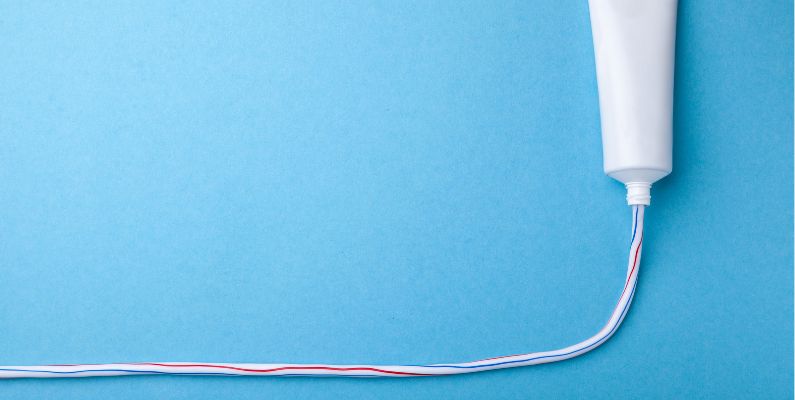
How it all began
“There are 2 kinds of people in the world, those that squeeze toothpaste from the bottom, and sociopaths.” (Anonymous)
A dentifrice is defined as a powder, paste, or liquid for cleaning the teeth according to Merriam-Webster. The word is derived from the Latin dentifricium, denti (tooth) and fricare (to rub). Dentifrice is also the French word for toothpaste. They are currently supplied as powders, pastes or gels and are used for cleaning, caries prevention, enamel remineralization, gum disease prevention, and whitening.
Early forms of toothpaste were powders composed of crushed eggshells, pumice, ash, and myrrh used by the ancient Egyptians as far back as 5000 BC. In China, herbal mints were mixed with salt and ginseng to clean the teeth. These powders in various forms were used until the 1850s.
Colgate in 1873, began producing toothpaste in jars. Dr. Washington Sheffield citing the unsanitary practice of multiple people dipping their toothbrushes into one jar of toothpaste developed the first toothpaste in a tube. In 1824, a dentist nicknamed “Peabody” added soap to dental paste. Chalk was added by John Harris in the 1850s. Soap remained a primary ingredient in toothpaste until it was replaced with sodium lauryl sulphate (SLS) in 1945.
Toothpaste didn't change much until Dentist and biochemist Joseph Muhler and inorganic chemist William Nebergall developed a cavity-preventing product using stannous fluoride. In 1956, Crest was the first to mass market the fluoridated toothpaste, becoming the first toothpaste recognized by the American Dental Association in 1960 as an effective decay-preventing agent. Toothpaste today contains water and three main ingredients: fluoride, abrasives, and detergents.
Fluoride
First introduced into toothpaste formulas in 1914, fluoride is arguably the most valuable component in toothpaste. The decline of tooth decay during the 20th century has been attributed to fluoride-containing toothpastes worldwide. Sodium fluoride (NaF) is the most common source of fluoride, but stannous fluoride (SnF2), and sodium monofluorophosphate (Na2PO3F) are also used. Stabilized stannous fluoride-containing toothpastes had a positive effect on the reduction of plaque, gingivitis and staining, with a significant reduction in calculus and halitosis compared to other toothpastes. Concentrations below 1,000 ppm are not efficacious for cavity prevention. The preventive effect increases with the concentration. For prevention of root caries in elderly adults, 5,000 ppm fluoride has been recommended.
Fluorides have also been promoted for remineralization of enamel. Remineralization of early dental caries is promoted naturally by saliva. Fluoride promotes remineralization but is limited by the bioavailable calcium. Hydroxyapatite nanocrystals and a variety of calcium phosphates have been used with dentifrices however more clinical evidence is required to substantiate their effectiveness.
The use of a dentifrice does not impact the level of plaque removal according to a 2016 systematic review by Valkenburg and Slot et al. This is likely due to fact that plaque removal is more a function of the toothbrushing efficacy, not the abrasive.
While the safety and efficacy of fluoride has been well established, large amounts of swallowed toothpaste can be toxic. Approximately 15 mg/kg body weight is the acute lethal dose, even though as small amount as 5 mg/kg may be fatal to some children. Another concern is for dental fluorosis in children under 12 months by ingesting excessive fluoride toothpaste.To reduce the risk to children, the American Academy of Pediatric Dentistry recommends parents use a tiny smear of fluoride toothpaste to brush baby teeth twice daily as soon as they erupt and a soft, age-appropriate sized toothbrush. Once children are 3 to 6 years old, then the amount should be increased to a pea-size dollop and perform or assist your child's toothbrushing.
Abrasives
Abrasives constitute 8-20% of a typical toothpaste. The abrasive effect of toothpaste is indicated by its RDA value. Toothpastes with RDA values above 250 are potentially damaging to the surfaces of teeth. The American National Standards Institute and American Dental Association considers toothpastes with an RDA below 250 to be safe and effective for a lifetime of use. After the Microbead-Free Waters Act of 2015, the use of microbeads in toothpaste has been discontinued in the USA.
A systematic review in 2017 concluded that nearly all dentifrices that are specifically formulated for tooth whitening were shown to have a beneficial effect in reducing extrinsic stains, irrespective of whether or not a chemical discoloration agent was added. However, the whitening process can permanently reduce the strength of the teeth, as the process scrapes away a protective outer layer of enamel.
Detergents
The purpose of a detergent is to loosen and break down substances on your teeth that would otherwise be insoluble. Early attempts at detergents incorporated soaps. Soaps are made from natural ingredients, such as plant oils (coconut, vegetable, palm, pine) or acids derived from animal fat. Detergents are synthetic, man-made derivatives. Detergents are also known as “surfactants,” (surface active agents). Currently, surfactants such as sodium lauryl sulfate (SLS) are used for uniform distribution of toothpaste, and cleaning improvement. SLS can be derived from coconut or palm kernel oil. One area of concern is increased oral irritation in individuals prone to aphthous stomatitis / ulceration (canker sores). A non-SLS containing dentifrice is recommended.
Recommendations
Dentifrices are safe and effective adjuncts for caries prevention. Care should be taken with whitening products and also the use in infants and children. Select a toothpaste with the American Dental Association’s (ADA) Seal of Acceptance and brush correctly.